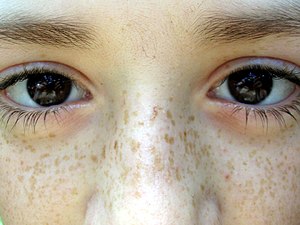There are concentrated areas of pigmentation of the skin called freckles and moles. However, there is a difference between the two. A freckle is a pigmentation of the innermost layer of the epidermis, which is the top layer of skin. Freckles occur as a result of exposure to the sun and most often appear on the shoulders or face and the tendency to develop freckles may be inherited. Freckles are benign and do not usually require any treatment. Freckling is not associated with cancer, but people with fair complexions are more susceptible to
skin cancer.
A mole is a cluster of cells called melanocytes (cells that produce melanin, the skin pigmentation) which is located in the top layer of the second skin layer (dermis). Moles are usually visible at birth and become more noticeable as you grow older. Moles tend to be small, but occasionally can grow large. They are most often benign, but sometimes can become cancerous.
You should watch moles carefully for changes and see your doctor immediately if concerns develop. Be observant for changes in:
- Size
- Shape
- Color
- Painfulness
Moles may be isolated or appear in clusters. People who have moles should examine their bodies carefully for changes. A mole that you have had may change, others may develop or become painful should have careful attention paid to them.
You can remember this by remembering A, B, C, D and E.
- Asymmetry, when half of the mole changes in size
- Border, when the edges of a mole are jagged
- Color, if color is uneven and changes from tan, brown, black, blue, red or white
- Diameter, if it is larger than a pencil eraser
- Elevation, when height variation is present
There are several different types of skin cancer and most are treatable if detected early and treated quickly. The real lesson here is, don’t forget to consider
your feet when it comes to sun protection. The skin on the top of your feet is delicate and has not been sun exposed all winter. Make sure you don’t forget SPF 50 and rub it in! Skin cancers can be removed by cutting them away and closing the skin with a stitch or two. Or your doctor may use a treatment where they freeze the area. Regardless of the treatment, you will have a more clear idea of what to look for in the future.
Dr. Bowman knows exactly what to look for. If you have suspicious moles or other spots on your feet,
contact him at (713) 467-8886 and get his professional advice. Don’t let these spots go unchecked.
References:
http://www.everydayhealth.com/info/v1pt00/skin-cancer?s_kwcid=TC|21765|skin%20cancer||S|e|9570087974&xid=g_dlp-v1pt00http://www.medicinenet.com/skin_cancer/article.htm





No comments:
Post a Comment